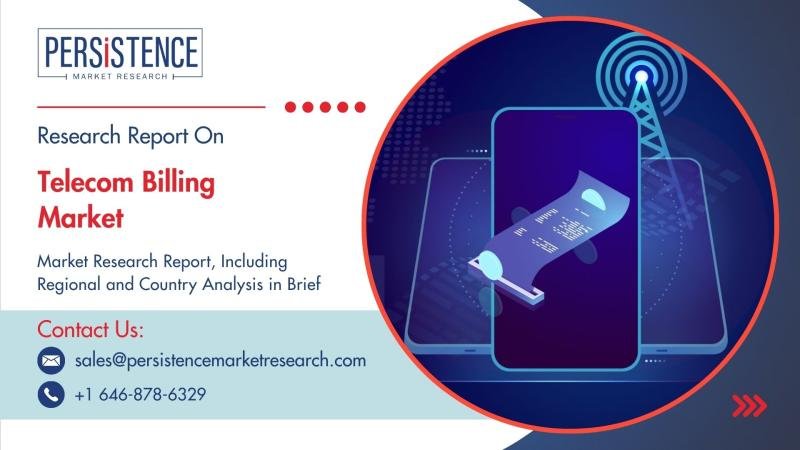Overview of the Telecom Billing Market
The global telecom billing market is undergoing a significant transformation, driven by the rise in mobile subscribers, rapid digitalization, and the need for accurate real-time billing systems. According to Persistence Market Research, the market is projected to grow robustly, reaching US$ 15.1 billion by 2032, from its current valuation. This growth is being propelled by the increased adoption of 5G technology, Internet of Things (IoT), and value-added services that require flexible, real-time billing mechanisms.
Billing and charging solutions currently dominate the telecom billing software segment due to their critical role in monetizing services, managing subscriber data, and preventing revenue leakage. Among deployment types, cloud-based billing platforms are gaining traction for their scalability, cost-effectiveness, and agility in deploying new services. Mobile operators remain the leading end-user category, accounting for the highest revenue share. North America holds the largest regional share, driven by early 5G adoption, high smartphone penetration, and the presence of key players offering advanced telecom billing solutions.
Get a Sample PDF Brochure of the Report (Use Corporate Email ID for a Quick Response): https://www.persistencemarketresearch.com/samples/32075
Key Highlights from the Report
➤ The global telecom billing market is projected to reach US$ 15.1 billion by 2032.
➤ Billing and charging software leads the market in terms of solution preference.
➤ Cloud deployment is gaining popularity due to lower infrastructure costs and scalability.
➤ North America remains the dominant region in the telecom billing industry.
➤ Mobile operators are the largest end-user group in the telecom billing market.
➤ Rising demand for real-time and convergent billing solutions fuels market growth.
Market Segmentation
The telecom billing market is segmented based on solution, deployment, and end-user. Under the solution segment, software remains the largest contributor and is further divided into billing and charging, fraud management, revenue assurance, and other modules. Billing and charging systems have emerged as indispensable tools in modern telecom operations, allowing operators to manage complex pricing models, multi-play service bundles, and prepaid-postpaid hybrid plans. Fraud management and revenue assurance solutions are also experiencing growth as operators seek to minimize financial losses and ensure operational efficiency.
By deployment, the market is bifurcated into cloud and on-premise models. While on-premise billing systems offer better control and security for large telecom operators, cloud deployment is rapidly gaining ground due to its lower upfront costs and ease of integration with other systems. In the end-user segment, mobile operators dominate the market with the largest share, followed by internet service providers and other service providers. The surge in mobile data traffic, expansion of 4G/5G networks, and the proliferation of connected devices are key factors driving demand from mobile operators.
Regional Insights
North America leads the global telecom billing market due to its mature telecom infrastructure and high demand for sophisticated billing systems. The region’s rapid adoption of 5G technology and innovative telecom services has placed pressure on operators to modernize their billing platforms. Moreover, the presence of major players like Oracle, Amdocs, and CSG International ensures continuous development of advanced solutions tailored to regional needs.
Asia Pacific is emerging as a high-growth region due to rising internet and mobile penetration in countries like India, China, and Southeast Asian nations. Government support for digitization, coupled with expanding telecom networks in rural areas, is creating new opportunities. With increasing competition among service providers, there is growing demand for real-time billing, customer self-service portals, and convergent billing solutions to improve customer experience and reduce churn.
Market Drivers
One of the primary drivers for the telecom billing market is the explosion of mobile users and internet-based services. Telecom operators are offering complex pricing plans that include multiple services like voice, data, and content subscriptions. To handle these bundled services effectively, robust and scalable billing systems are essential. Additionally, the advent of 5G networks is accelerating the demand for dynamic billing solutions capable of managing low-latency, high-volume transactions.
Moreover, the rise in machine-to-machine (M2M) communication and IoT applications is compelling telecom companies to adopt sophisticated billing frameworks. The need to monitor data usage, control service levels, and provide itemized billing is more critical than ever. Convergent billing systems that unify multiple services under one platform are especially in demand as they simplify customer management and improve revenue collection.
Market Restraints
Despite its growth potential, the telecom billing market faces several challenges. One of the major restraints is the complexity and high cost associated with upgrading legacy billing systems. Many telecom operators still use outdated infrastructures that lack flexibility and cannot support new-age digital services. Transitioning to modern platforms often involves significant capital expenditure, training, and potential service disruptions.
In addition, data privacy concerns and stringent regulatory requirements around billing accuracy and transparency can pose hurdles. For example, telecom operators must comply with international standards and local regulations, which may vary widely across regions. Integration issues with other operational systems such as CRM, OSS, and ERP platforms also limit the seamless deployment of new billing solutions, especially in emerging markets.
Market Opportunities
The telecom billing market presents several opportunities, particularly in the areas of AI, automation, and predictive analytics. AI-powered billing platforms can detect anomalies, optimize pricing, and even predict customer churn, thereby enhancing revenue assurance and customer satisfaction. Integration with blockchain for transparent and tamper-proof transactions is another innovative opportunity, especially in B2B telecom services.
Furthermore, the growing emphasis on customer-centric billing models such as pay-as-you-go or subscription-based billing opens up new market segments. Small and medium-sized telecom providers can leverage cloud-based billing solutions to reduce operational costs while maintaining high service quality. Emerging markets in Latin America and Africa, which are rapidly digitizing, offer untapped potential for vendors offering scalable and affordable billing systems.
For Customized Insights on Segments, Regions, or Competitors, Request Personalized Purchase Options@ https://www.persistencemarketresearch.com/request-customization/32075
Frequently Asked Questions (FAQs)
➤ How big is the telecom billing market in 2025 and what is its projected growth by 2032?
➤ Who are the key players in the global market for telecom billing?
➤ What is the projected growth rate of the telecom billing market?
➤ What is the market forecast for telecom billing through 2032?
➤ Which region is estimated to dominate the telecom billing industry through the forecast period?
Company Insights
✦ Amdocs
✦ Netcracker
✦ CSG International
✦ Huawei
✦ Mahindra Comviva
✦ Nokia
✦ SAP
✦ Hewlett Packard Enterprise (HPE)
✦ FTS
✦ Oracle
✦ Optiva
Recent Developments
■ In 2024, Amdocs announced the launch of a new cloud-native telecom billing solution to support 5G monetization and multi-partner ecosystems.
■ Oracle collaborated with a major European telecom operator in 2023 to deploy AI-enhanced billing analytics for personalized customer offerings.
This article offers a comprehensive overview of the telecom billing market, emphasizing its transformative growth, segmentation, key players, and future potential. The integration of real-time capabilities, AI-driven insights, and customer-centric billing models is expected to redefine the market landscape through 2032.
Explore the Latest Trending “Exclusive Article” @
• https://www.linkedin.com/pulse/portable-power-station-market-trends-driving-future-clean-ajay-patil-b5sqf/
• https://medium.com/@apnewsmedia/portable-power-station-market-insights-revealing-growth-opportunities-b8f661f17841
• https://webrankmedia.wordpress.com/2025/05/05/portable-power-station-market-analysis-shows-surge-in-outdoor-demand/
• https://webrankmedia.blogspot.com/2025/05/portable-power-station-market-growth.html
• https://vocal.media/stories/portable-power-station-market-expansion-fueled-by-remote-work-culture
Contact Us:
Persistence Market Research
G04 Golden Mile House, Clayponds Lane
Brentford, London, TW8 0GU UK
USA Phone: +1 646-878-6329
UK Phone: +44 203-837-5656
Email: sales@persistencemarketresearch.com
Web: https://www.persistencemarketresearch.com
About Persistence Market Research:
At Persistence Market Research, we specialize in creating research studies that serve as strategic tools for driving business growth. Established as a proprietary firm in 2012, we have evolved into a registered company in England and Wales in 2023 under the name Persistence Research & Consultancy Services Ltd. With a solid foundation, we have completed over 3600 custom and syndicate market research projects, and delivered more than 2700 projects for other leading market research companies’ clients.
Our approach combines traditional market research methods with modern tools to offer comprehensive research solutions. With a decade of experience, we pride ourselves on deriving actionable insights from data to help businesses stay ahead of the competition. Our client base spans multinational corporations, leading consulting firms, investment funds, and government departments. A significant portion of our sales comes from repeat clients, a testament to the value and trust we’ve built over the years.
This release was published on openPR.














